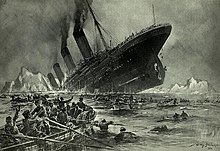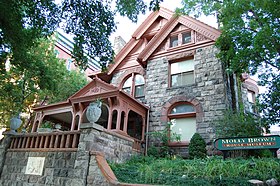Margaret Brown
Margaret Brown | |
|---|---|
Titanic sinking | |
| Spouse | |
| Children | 2 |
| Parents |
|
Margaret Brown (née Tobin; July 18, 1867 – October 26, 1932), posthumously known as the "Unsinkable Molly Brown", was an American
During her lifetime, her friends called her "Maggie", but by her death, obituaries referred to her as the "Unsinkable Mrs. Brown".[2] Gene Fowler referred to her as "Molly Brown" in his 1933 book Timberline.[3] The following year, she was referred to as the "Unsinkable Mrs. Brown" and "Molly Brown" in newspapers.[4]
Early life
Margaret Tobin was born on July 18, 1867,[5][6][7] near the Mississippi River in Hannibal, Missouri, on Denkler's Alley.[6][a] The three-room cottage where she was born is now the Molly Brown Birthplace and Museum; it is on 600 Butler Street in Hannibal.[6][8] Her parents were Irish Catholic immigrants John Tobin and Johanna (Collins) Tobin.[9][b] Her siblings were Daniel Tobin, Michael Tobin, William Tobin, and Helen Tobin. Both of Margaret's parents had previously been married to other spouses who had died. Brown had two half-sisters: Catherine Bridget Tobin, by her father's first marriage, and Mary Ann Collins, by her mother's first marriage.[12] Called Maggie by her family, she attended her maternal aunt Mary O'Leary's grammar school, which was across the street from her home. Nearby was also the Hannibal Gas Works where her father worked as a laborer. Their neighborhood was a tight-knit Irish Catholic community, where people traveled westward through the town for the gold fields.[13]: 63
At age 18, Margaret relocated to Leadville, Colorado, with her siblings Daniel Tobin, Mary Ann Collins Landrigan, and Mary Ann's husband John Landrigan. Margaret and her brother Daniel shared a two-room log cabin, and she found work sewing carpets and draperies at a dry goods store,[12] Daniels, Fisher and Smith. Daniel was a miner.[14]
Marriage and children

In Leadville, she met and married James Joseph Brown (1854–1922), nicknamed "J.J.", an imaginative, self-educated man. He was not a rich man, and she married J.J. for love. After his death she said,
I wanted a rich man, but I loved Jim Brown. I thought about how I wanted comfort for my father and how I had determined to stay single until a man presented himself who could give to the tired older man the things I longed for him. Jim was as poor as we were and had no better chance. I struggled hard with myself in those days. I loved Jim, but he was poor. Finally, I decided that I'd be better off with a poor man whom I loved than with a wealthy one whose money had attracted me. So I married Jim Brown.[15][16]: 44–45
Margaret and J.J. married in Leadville Annunciation Church on September 1, 1886.[12] They had two children: Lawrence Palmer Brown (1887–1949), known as Larry, and Catherine Ellen Brown (1889–1969), known as Helen.[16]: 51, 52, 117 They also raised three of their nieces: Grace, Florence, and Helen Tobin.[13]: xxiv
Mining success
In 1893, the Brown family acquired great wealth when J.J.'s mining engineering efforts proved instrumental in the exploration of a substantial ore seam at the Little Jonny Mine.[16]: 56–57 His employer, Ibex Mining Company, awarded him 12,500 shares of stock and a seat on the board.[17] In Leadville, Margaret helped by working in soup kitchens to assist miners' families.[18]

In 1894, the Browns bought a Victorian mansion, now known as the
J.J. was not interested in the social life that Brown enjoyed and the couple began to drift apart.[20] After 23 years of marriage, Margaret and J.J. privately signed a separation agreement in 1909. She received a US$700 monthly allowance (equivalent to $24,000 in 2023) to continue her travels and political work.[13]: 167
Brown assisted in fundraising for
Passenger on the Titanic
Brown spent the first months of 1912 in Paris, visiting her daughter and as part of the

After her death in 1932, Brown was called "Molly Brown" and "The Unsinkable Mrs. Brown" by authors
Upon being rescued by the ship RMS Carpathia, Brown proceeded to organize a committee with other first-class survivors. The committee worked to secure basic necessities for the second- and third-class survivors, and even provided informal counseling.[24]
Later life and death
In 1914, six years before the Nineteenth Amendment granted women the right to vote, Brown ran for Colorado's U.S. Senate seat, but she ended her campaign to serve abroad as the director of the American Committee for Devastated France during World War I. Also in 1914, she contributed to miners and their families during the 1914 Ludlow coal mine disaster[20] and she helped organize the International Women's Rights conference that year, which was held in Newport, Rhode Island.[25]
During and after World War I, she worked in France with the
J.J. Brown died on September 5, 1922.[13]: 220 Margaret told newspapers, that although she had met royalty and other great people around the world, "I've never met a finer, bigger, more worthwhile man than J.J. Brown."[13]: 217 J.J. Brown left vast, yet complicated, real estate, mining, and stock holdings. It was unknown to the Browns and their lawyers how much was left in the estate. Prior to J.J.'s death, he had transferred a large amount of money to his children. Their children were also unaware how much money Margaret had, but were displeased at the large amounts she spent on charity. Margaret Brown and her children fought in court for six years to settle the estate.[13]: 220–221
In the 1920s, Margaret Brown focused her energy on personal passions, especially the theater. She died in her sleep at 10:55 p.m. on October 26, 1932, at age 65, in New York City's
Legacy
Brown’s fame as a Titanic survivor helped her promote the philanthropic and activism issues she felt strongly about.[20] She was concerned about the rights of workers and women, education and literacy for children, historic preservation, and commemoration of the bravery and chivalry displayed by the men aboard the Titanic.[13]

Avoca Lodge, known as
The three-room cottage where Brown was born is now the Molly Brown Birthplace and Museum; it is on 600 Butler Street in Hannibal, Missouri.[6][8]
The theme park Disneyland Paris features a 19th-century riverboat attraction, the Molly Brown Riverboat, named after her.[28]
In 1965, astronauts Gus Grissom and John Young named their Gemini spacecraft Molly Brown in her honor.[29]


Brown’s Denver, Colorado home has been a museum since 1971.[30] It is called the Molly Brown House Museum.[31] There is a trail marker outside it as part of the National Votes for Women Trail;[32] the marker was stolen in November 2023, but was found later that month.[31]
In 1985, Brown was inducted into the Colorado Women's Hall of Fame.[20]
Portrayals
- Thelma Ritter (1953) (Titanic). Brown's name was changed to Maude Young, and her Colorado gold mining fortune became a Montana lead mining fortune.
- Cloris Leachman (1957) (Telephone Time) ("The Unsinkable Molly Brown")
- Tucker McGuire (1958) (A Night to Remember)
- Tammy Grimes (1960) (The Unsinkable Molly Brown) (Broadway musical) Grimes won a Tony Award for her performance.
- Debbie Reynolds (1964) (The Unsinkable Molly Brown). Reynolds received an Academy Award nomination for Best Actress.
- Cloris Leachman (1979) (S.O.S. Titanic) (TV movie)
- Fionnula Flanagan (1983) (Voyagers!) ("Voyagers of the Titanic")
- Titanic) (TV miniseries)
- Kathy Bates (1997) (Titanic)
- Judy Prestininzi (2003) (Ghosts of the Abyss) (Documentary)
- Titanic) (TV series/2 episodes)
- Beth Malone (2020) (The Unsinkable Molly Brown) (Off Broadway revival)
Notes
- ^ The street was also known as Denkler Alley and Denklers Alley.
- slave state. By 1860, Tobin lived in Hannibal, Missouri, which was a major "gateway to freedom" on the Underground Railroad. John Tobin served in the Union militia in Missouri, which was a slave state.[11]
- RMS Titanic, however, she was invited to lunches by socialites.[22]
References
- ^ ISBN 978-1-85285-434-8.
- ^ a b c "Quiet Services Held for 'Unsinkable Mrs. Brown'". The San Bernardino County Sun. November 1, 1932. p. 2. Retrieved September 4, 2022.
- ^ a b "Books and Things – Gene Fowler's "Timber Line" book mentions Molly Brown". The Charleston Daily Mail. November 2, 1933. p. 6. Retrieved May 1, 2023.
- ^ a b "Deeds of Heroism Seemed the Natural Action of "The Unsinkable Mrs. Brown"". The Kansas City Times. January 11, 1934. p. 16. Retrieved May 1, 2023.
- ^ "Margaret Tobin Brown" (PDF). Molly Brown House Museum. Retrieved September 2, 2022.
- ^ a b c d Marks, Lisa (June 29, 2017). "Celebrating Molly Brown on her 150th birthday". Hannibal Magazine.
- ^ "Molly Brown – American parvenue". Britannica. Retrieved September 2, 2022.
- ^ a b "Molly Brown Birthplace". Visit Hannibal. Retrieved September 4, 2022.
- ^ a b c Harbold, Laura (May 2007). "BEYOND Unsinkable". The National Endowment for the Humanities. Retrieved July 23, 2022.
- ^ Malcomb, Andrea (June 30, 2019). "Irish Diaspora and Colorado". Molly Brown House Museum. Retrieved August 16, 2023.
- ^ ISBN 978-1-61423-924-6.
- ^ a b c Harper, Kimberly. "Molly Brown (1867–1932)". Historic Missourians. State Historical Society of Missouri. Retrieved July 23, 2022.
- ^ a b c d e f g h i j k Iversen, Kristen (1999). Molly Brown: Unraveling the Myth. Boulder: Johnson Books.
- ^ "Collection: Margaret "Molly" Tobin Brown Papers – Identifier WH53 – Microfilm Mflm175". Denver Public Library Archives, Western History and Genealogy. Retrieved September 12, 2022.
- ISBN 978-0-8065-3609-5.
- ^ ISBN 978-0-395-93912-3.
- ^ National Mining Hall of Fame and Museum (January 3, 2007). "Ibex Mining Company buildings". Mines Repository. Retrieved September 4, 2022.
- ^ Kinder, Libby (June 26, 2020). "Such a Fine Sight to See: Setting the record straight at Margaret Tobin Brown's lavish home in downtown Denver". Gazette Cheyenne Edition. Retrieved September 4, 2022.
- ^ a b "Molly Brown | American parvenue". Encyclopedia Britannica. Retrieved December 1, 2018.
- ^ a b c d e "Margaret "Molly" Tobin Brown". Colorado Women's Hall of Fame. Retrieved September 6, 2022.
- ISBN 978-1-55566-214-1.
- ^ "High Society and the Mining Hall of Fame". Colorado Central Magazine. September 1, 2005. Retrieved August 16, 2023.
- ^ a b c d Pak, Eudie (August 2, 2019). "Molly Brown and 11 Other Famous Titanic Passengers". Biography. Retrieved September 4, 2022.
- ^ Cimino, Eric (Fall 2017). "Carpathia's Care for Titanic's Survivors". Voyage, Journal of the Titanic International Society. 101: 28.
- ISBN 978-0-8368-5130-4.
- ^ "Mrs Margaret Brown (Molly Brown) (née Tobin)". Encyclopedia Titanica. Retrieved April 19, 2016.
- ISBN 1555662374.
- ^ "Thunder Mesa Riverboat Landing". Disneyland Paris. Retrieved March 25, 2023.
- ISBN 978-0-307-75686-2. Retrieved March 17, 2024.
- ^ "Denver's Molly Brown House Was Almost Lost To Bulldozers. Now, It's Celebrating 50 Years As A Museum". Colorado Public Radio. April 13, 2021.
- ^ a b "'Votes for Women' sign stolen from Molly Brown House Museum has been returned". KUSA.com. November 7, 2023.
- ^ "Historic Denver Hosted Marker Dedication for Molly Brown".
Further reading
- Lohse, Joyce B. (2006). Unsinkable: The Molly Brown Story. Filter Press. ISBN 978-0-86541-081-7.
External links
- Margaret Brown at Find a Grave
- Molly Brown House Museum, Denver
- "Louise Sneed Hill and Denver's "Sacred Thirty-Six" - Fairmount Cemetery". Fairmount Cemetery. April 23, 2013. Archived from the original on July 2, 2018.
